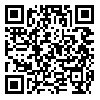Volume 14, Issue 2 (Summer 2022)
tkj 2022, 14(2): 1-11 |
Back to browse issues page
Ethics code: IR.BUMS.REC.1399.459
Download citation:
BibTeX | RIS | EndNote | Medlars | ProCite | Reference Manager | RefWorks
Send citation to:



BibTeX | RIS | EndNote | Medlars | ProCite | Reference Manager | RefWorks
Send citation to:
Baloochi Beydokhti T, solaimani moghaddam R. Prevalence investigation and Comparison of Anxiety of Pre-Hospital Emergency and Hospital Emergency Personnel in Birjand in Covid-19 Epidemic. tkj 2022; 14 (2) :1-11
URL: http://tkj.ssu.ac.ir/article-1-1189-en.html
URL: http://tkj.ssu.ac.ir/article-1-1189-en.html
Msc in Nursing, Birjand University of Medical Sciences, Birjand, Iran , rasool.solaimani@yahoo.com
Abstract: (1193 Views)
Introduction: Coronavirus is a large family of viruses that may cause respiratory infections. Recently, a new coronavirus epidemic (COVID-19) has caused great anxiety worldwide. Given that pre-hospital and hospital emergency staffs are the first group of frontliners to be exposed to and fight COVID-19 infection, this study aimed to investigate the anxiety of pre-hospital and hospital emergency staff in Birjand during the COVID-19 pandemic.
Materials and Methods: In this descriptive cross-sectional study, 270 pre-hospital and hospital emergency personnel were included in the census method in 2021. Data collection tools included a demographics form and the Coronavirus Anxiety Scale (CDAS). Data analysis was performed in SPSS software version 21 using descriptive and inferential statistical tests.
Results: The mean score of psychological symptoms of pre-hospital emergency personnel (20.65%) was higher than hospital emergency personnel (17.78%). Also, the mean score of physical symptoms of pre-hospital emergency personnel (16.09%) was greater than that of hospital emergency personnel (17.73). There was a significant difference between pre-hospital and hospital emergency personnel regarding the mean anxiety score (P <0.001).
Conclusion: Considering these results and the associated morbidity rate in healthcare providers caused by their presence in the first line of treatment against the COVID-19 infection, health policymakers are suggested to take the necessary steps to reduce the anxiety of the medical staff.
Materials and Methods: In this descriptive cross-sectional study, 270 pre-hospital and hospital emergency personnel were included in the census method in 2021. Data collection tools included a demographics form and the Coronavirus Anxiety Scale (CDAS). Data analysis was performed in SPSS software version 21 using descriptive and inferential statistical tests.
Results: The mean score of psychological symptoms of pre-hospital emergency personnel (20.65%) was higher than hospital emergency personnel (17.78%). Also, the mean score of physical symptoms of pre-hospital emergency personnel (16.09%) was greater than that of hospital emergency personnel (17.73). There was a significant difference between pre-hospital and hospital emergency personnel regarding the mean anxiety score (P <0.001).
Conclusion: Considering these results and the associated morbidity rate in healthcare providers caused by their presence in the first line of treatment against the COVID-19 infection, health policymakers are suggested to take the necessary steps to reduce the anxiety of the medical staff.
Type of Study: Research |
Subject:
occupational medicine
Received: 2022/05/9 | Accepted: 2022/08/25 | Published: 2022/09/6
Received: 2022/05/9 | Accepted: 2022/08/25 | Published: 2022/09/6
Send email to the article author
| Rights and permissions | |
 |
This work is licensed under a Creative Commons Attribution-NonCommercial 4.0 International License. |







